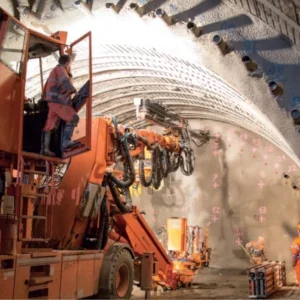The traditional purpose of grouting in connection with tunnel excavation has been to prevent major water inflows and reduce the amount of water that has to be pumped out of the tunnel system. In many cases, grouting has only been considered as a contingency activity, used to solve a water inflow problem after it has occurred. Some people have also appreciated the potential stabilising and strengthening of the rock mass as a result of grouting. In fact, such effects can be described in a scientific manner. Up to now, however, limitations in the material properties and grouting technology have constrained the predictability of the rock mass improvement effect from grouting.
Recent developments in grouting materials and grouting technology in Norway are improving the possibility of achieving rock improvements by grouting. The key benefits offered by the new developments in materials are:
– high penetration, important to access material filled water-bearing joints (penetration to a levvel to achieve permeability close to 0.1 Lugeon);
– stable grout in the liquid phase (<2% bleeding, water loss);
– little or no shrinkage during hardening (<1-2% volume loss);
– ability to “guide” the low viscosity grout into a low permeability zone surrounding the tunnel;
– high final strength;
– environmental safety and long durability of the
grouting materials.
Some of these properties (especially volume stability and strength) can be implied and actually modelled in classification systems describing the rock mass quality, such as the Q-system and to some extent RMR. By such analysis, the effect of grouting can be described in terms of rock mass quality:
– rock quality before grouting;
– rock quality after grouting;
– Using the predicted rock quality after grouting and the known rock quality before grouting, it is possible to estimate time and cost savings that can be achieved by grouting.
In addition, it is possible to describe how grouting may influence the feasibility of excavation in bad rock conditions.
How grouting influences rock quality
It is generally accepted that pre-grouting can improve the quality of a rock mass. There is qualitative and quantitative experience from excavation in rock and dam foundations, where tests in galleries usually show increased deformation moduli after injection. We refer to examples of velocity increase as a function of reduced Lugeon value, and connect these changes to increased rock mass quality. The reasons for increased rock mass quality and easier excavation are due to any or all of the following:
– filling of joints and voids;
– closing of secondary joints;
– “glueing” and strengthening of parts of the rock mass;
– reduction of water flow and the resulting improvement in excavation conditions and reduction in rock support requirements such as shotcreting and bolting.
Assuming that suitable materials and methods are available for the job, it is desirable to predict what results are achievable to justify the injection operation. This is best accomplished using the relationship between rock support needs and rock mass quality parameters, as described in the Q-system and RMR method. If the effect of injecting the rock mass can be described by quantitative changes of some of the parameters, then a positive link to rock support needs, length of round, cycle time and cost can be established, using the improved Q-value or RMR-value as the basis.
To be able to evaluate the effect injection will have on the parameters that constitute these empirical based classification methods, we must establish a model of how the injection materials penetrate the rock mass.
There are two basic methods for penetration – through natural or induced joints or fractures, or through the pores in the rock. The latter applies to weak, very porous rocks, but can also apply to crushed rock, as in weakness zones where weathering or alteration have occurred.
Whatever the model for penetration, the injection materials will follow the path of least resistance. This means that canals or joints with highest conductivity will take the largest volumes and experience the furthest spreading. If high enough pressure is used to hydraulically split the rock mass, the joint set with lowest normal stress (and highest permeability) will accept the grout first. This will tend to occur even with moderate pressure, if the permeability of the joint set is sufficient.
In a rock mass with several joint sets and canals there will be some canals and joints that fill with grout, while other sets or canals may be little affected or unaffected, at least when injecting with low pressure. If a grouting pressure that is higher than the hydraulic jacking pressure is used, the associated deformation or consolidation can nearly close some of the joints where no grout penetrates. This gives a double benefit of grouting.
It is considered very likely that joints and canals that are easiest to penetrate are also the defects in the rock mass that weaken it most. The addition of grout will not generally remove any of the original material in the rock mass such as clay coatings, but pore water and joint water will obviously tend to be displaced. Changes in the rock mass properties must therefore be associated with the properties of the grouting materials and the effect these have within the joints and canals.
There will also be a certain change in the stress situation, due to the consolidation. Since parts of the voids have been filled under pressure, transfer of stress across the joint walls will have been improved and made more uniform. High stress can therefore be borne more efficiently, since it is transferred across larger areas than original rock-to-rock asperity contacts.
Both cement-based grouts and chemical grouts will improve the properties of the rock mass. However, the weakest chemical grouts such as waterglass and acrylates have elastoplastic deformation properties and very low strengths (+/- 0.01MPa) so that they may only offer water-stop effects. The strength and deformation properties of the rock mass as a whole might even be compromised.
Epoxy and polyurethane and stabilised cements are dependent on their formulation strengths of tens up to 100MPa. Epoxy and some polyurethanes have good bonding properties, with strengths that can approach that of middle-strong to medium-weak rocks, respectively. Hardened cement grout will behave as medium to low-strength rock, with strength of, say, 10% to 20% of that of hard rocks. This is more than sufficient in relation to the usually much lower strength of the rock mass. All these grout materials are watertight when hardened. In a loading situation, the beginning of plastic deformation will likely occur in the following order: polyurethane, epoxy, cement.
In this discussion of potential rock quality improvements, which will include strength, deformability, seismic velocity, permeability and reinforcement needs, it will be assumed that the choice of drill pattern, pressures and grouts ensure that a significant volume of the rock mass is partially penetrated by the chosen grout.
The paths of least resistance will be the chief areas directly affected by the grout, i.e where grout-rock contact actually occurs.
Potential for quality improvement
The Q-system of rock mass classification, which is also used as a tunnel support design aid, encompasses a number of key parameters. In principle, the relative block size (@RQD/Jn), the inter-block shear strength (Jr/ Ja), the permeability and inflow (Jw), and the stress/strength-ratio or degree of consolidation (SRF) are each accounted for in the formula of Barton et al 1974.
Q= RQD/Jn)x (Jr/Ja) x (Jw/SRF) (1)
Block size
A change of the relative block size (RQD/Jn) will require “elimination” of some joints, perhaps even many joints in a set. Some canals along other sets might even be penetrated. For the effective block size to be changed, the penetrated joints will need to have increased strength produced by direct grout penetration and bonding, combined with increased shear strength for those joints that are preferentially “closed” by the grouting pressure and consolidation.
An upper limit case will be a finely crushed zone with limited fines, where the injected mass approaches the properties of an “in situ concrete”. In such an idealised case, RQD would be returned to 100% and Jn would be returned to 0.5 or 1.0. An improvement in (RQD/Jn) from 10/(15 or 20) to 100/(0.5 or 1.0) for this ideal case would mean a potential maximum possible increase of the (RQD/Jn) ratio from 0.66 or 0.5 to 100 or 200, meaning a partial Q-factor increase of 150 to 400 in the affected location.
In more normal cases, a certain increase in RQD, say from 30 to 60 and a reduction in up to one joint set, say from Jn=9 to Jn=4 would be more likely. This would give a partial Q-factor increase of about 4. A range of 2 to 6 might be typical. (i.e Jn=6 to Jn=4 and RQD=70 to RQD=90, giving 1.9, or Jn=12 to Jn=4 and RQD=25 to RQD=50, giving 6.0). These examples describe an easier grouting process and rockmass benification when quality starts out lowest, which is obviously consistent with experience, since RQD/Jn represents to a great extent the potential connectivity and permeability of the rock mass as a whole. The factor Ja may change this in either direction.
Joint properties
The inter-block friction represented by Jr/Ja, where tan-1 (Jr/ Ja) in fact closely resembles some measured ranges of friction angles (Barton, 1995) has the two components of roughness and eventual joint filling or alteration. In cases where rock-to-rock contact is absent even with shear deformation (nominal Jr)=1 and Ja=6 (or more) an increase to Jr=2 or 3 and a decrease to Ja=4 or 3, represents a possible partial Q-factor increase of 3 to 9.
The Ja description of discontinuity infilling can in principle be moved up some classes if the grout added is stronger than the original filling, better still if it can mix with the fill. The effect on silty-sand filled discontinuities would be an obvious positive example. In clay, mineral coated joints or minor faults the grout would in some cases have little effect, unless good penetration is achieved and some bonding takes place. So, in general, in filled discontinuities the grout will give a positive increase in quality due to the consolidation and the penetration and potential strengthening of the non-clay or soft filling.
In typical cases of rock masses intersected by several sets of joints, there will be a tendency for permeability anisotropy due to directional jointing differences, and to common horizontal stress-anisotropy (σH >σh). The vertical stress difference to sH may also be enough to make a specific set a preferential, general pathway for the grout. In general, a minimum principal stress perpendicular to the most easily penetrated set will be expected.
If the most critical (and Jr/Ja determining) joint set is effectively almost “eliminated” by the grouting, then the ratio Jr/ Ja might, for example, change from 2/2 for set 1 (the dominant, oldest and most continous set) to 3/1 for set 2 (a less well developed set, with reduced permeability and joint continuity). Before sceptics object to this perhaps radical, though fundamental suggestion, the experiences of Quadros and Filho, 1995 should be related.
Simultaneous, multiple borehole and multiple-packer-multiple-piezometer “hydrotomography” tests performed at Brazilian dam site foundations by IPT Sao Paulo have shown dramatic changes to 3D permeability tensor magnitudes and direction in before-and-after grouting tests (using three new permeability test holes in the same location as the pre-grouting permeability test holes).
A rotation of the permeability tensor from the trend of a major set to a minor set of joints has been proved by structural geologists. In these, very permeable rock masses (K=10-4 to 10-5 m/s) the improvement, even with normal cement grouts is more than one order of magnitude (eg K=10-4 or 10-5 to K=10-6 m/s). At Pirapora Dam, Kmax rotated some 70o, and Kmin rotated some 140o. By chance, or good physics, deformability anisotropy and velocity anisotropy also result from these frequent stress and permeability anisotropies (Figures 1 and 2).
The concluding part of this paper will appear in the January issue of T&TI.
Related Files
Figure 3
Figure 4
Figure 1
Figure 2
Figure 5






